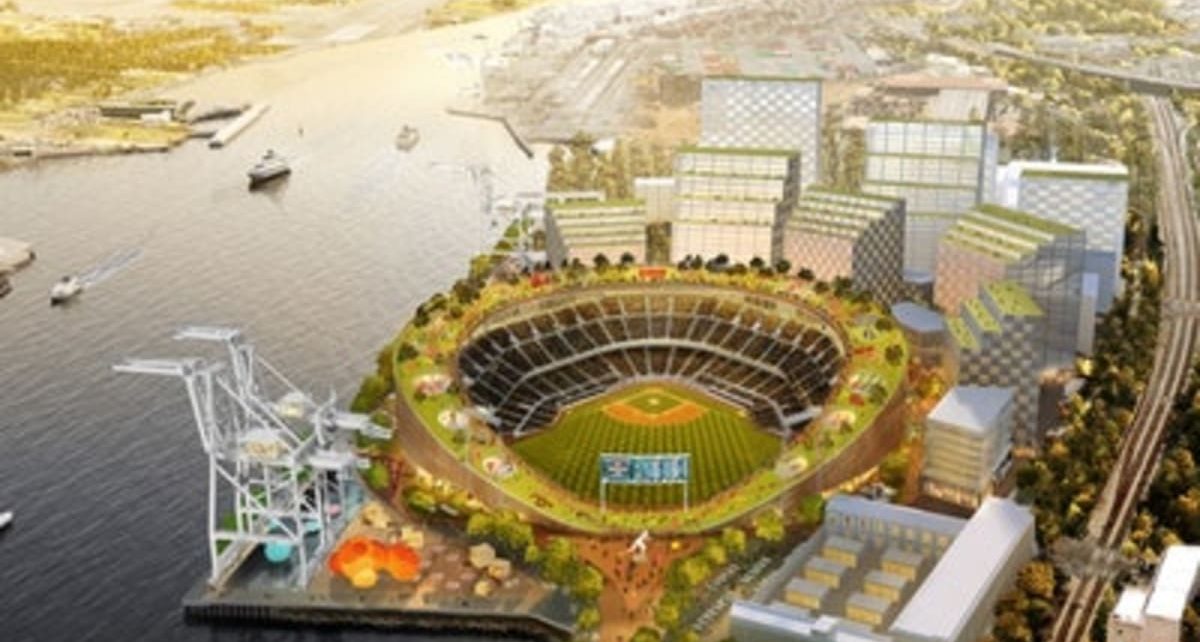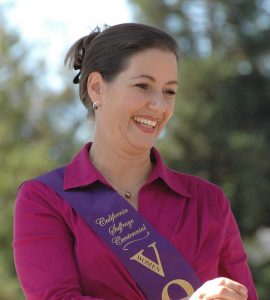
Proposed Howard Terminal Stadium in Oakland (Photo: Pinterest)
Alameda County Board of Supervisors Votes To Keep New Athletics Stadium Plan Alive In 4-1 Vote
‘Schaaf is already known as the Mayor who lost the Warriors and the Raiders’
By Evan Symon, October 27, 2021 3:52 pm
In a non-binding 4-1 vote, the Alameda County Board of Supervisors agreed to keep a new Oakland Athletics baseball stadium project alive at Howard Terminal, saving, for now, the last major team still playing in Oakland.
For the past 15 years, the Oakland Athletics have been trying to build a new stadium somewhere in Alameda County due to deteriorating conditions at the current Oakland Coliseum, but multiple plans have fallen through. In 2013, a plan to move the team to San Jose met a similar fate due to court action and the inability to fund a stadium, with a Supreme Court ruling officially ending the San Jose bid.
By the mid 2010’s, age issues with the stadium, as well as multiple other issues such as sewage leaks, led to new stadium demands from the Athletics and the NFL’s Oakland Raiders. The Golden State Warriors, an NBA team playing at next door Oracle Arena, also demanded a new arena under similar circumstances. With no agreements in place, the Warriors moved to the Chase Center in San Francisco in 2019, while the Raiders moved to Las Vegas in 2020.

With pressure mounting not to lose the sole remaining team in the city, as well as the Howard Terminal site plan growing stagnant and Oakland A’s leaders visiting potential relocation cities such as Las Vegas, the Board of Supervisors decided to vote Tuesday to keep the Oakland option alive.
Tuesday’s meeting went on for hours due to the Howard Terminal Stadium plan being discussed, but was ultimately voted for with a 4-1 vote.
Supporters for the plan pushed for the site as both an economic moneymaker for the city due to Athletics games and other stadium uses fueling nearby businesses and generating more tax revenue for the city, as well a catalyst for more affordable housing and parks in a part of the city where it is known mostly for industrial blight. According to the Howard Terminal plan, the ballpark plan would include a 35,000 seat stadium, a 400 room hotel, 3,000 affordable housing units, 1.8 million feet of commercial space, and 3,500 seat outdoor performance arts venue.
“We’re not asking you to be in the sports business, we’re asking you to be in the affordable housing and public parks business along with us, to be our hometown heroes,” said Oakland Mayor Libby Schaaf before the vote. “This vote has been the largest unknown in the entire project. Without the county’s participation, city officials cannot craft a development agreement. And that is the biggest job ahead of us.”
Let’s go Oakland! Tonight's vote by @AlamedaCounty paves a clear path to keep the A’s rooted in Oakland + build a world-class waterfront ballpark district that will benefit Bay Area residents for generations to come. 1/3 pic.twitter.com/6vU2EQn7Vq
— Libby Schaaf (@LibbySchaaf) October 27, 2021
A’s president Dave Kaval also noted on Tuesday, “We’re under a lot of pressure from Major League Baseball to come up with a new stadium solution. Time is running out.”
The future of the A’s in Oakland
However, those opposing the plan, including many port workers, have said that the stadium would wreck that part of the port, would ruin revitalization chances elsewhere in the city, and, due to public funds being given as a compromise, would be another example of taxpayer money going towards helping billionaires.
“We have a major shipping crisis right now and a public unwilling to build a new stadium,” said Port of Oakland worker Zach Johnson to the Globe on Wednesday. “And what do they do? They want to put a stadium right by a port terminal. They’re so desperate to keep the team that they think this is a good idea.”
After the vote, Supervisor Keith Carson, the sole no vote, noted that “Once we take a non-binding position it’s almost impossible to take it back.”
The vote specifically gives the County a non-binding agreement to setting up an Enhanced Infrastructure Financing District (EIFD)to help fund the stadium project, with funds to be given over a 45-year period.
It is also far from the last step in the process, as the city of Oakland still has much to approve, such as a term sheet agreement with the team, as well as getting an Environmental Impact Report passed.
“The stadium is a key piece for Oakland both economically and politically,” Bay Area political advisor Jackie Avery told the Globe on Wednesday. “This is why it’s such a big deal. Schaaf is already known as the Mayor who lost the Warriors and the Raiders. She doesn’t want to go down as the Mayor who took Oakland off the professional sports map completely. And many on Oakland’s City Council and other elected positions either. Cities who lose pro teams, well, it never does any good for the politicians who threw so much towards keeping them. San Diego, Montreal, Charlotte, St. Louis, and other recent relocation cities have seen huge political shifts at least in part due to teams leaving in the immediate wake of it happening. Even keeping a team can bring upheaval with major politicians being more closely monitored as a result and scandals being found out. Sacramento had many problems after narrowly keeping the Kings some years back.”
“Oakland’s just the newest city to join the fracas.”
More negotiations and agreements over the Howard Terminal site are expected in the coming months.
- Tesla Lays Off 3,332 Employees In California - April 23, 2024
- Southern California Steelhead Trout Added To State Endangered Species List - April 23, 2024
- Brightline West Project Has Groundbreaking Ceremony In Las Vegas - April 23, 2024





Oakland should take their chips and leave California like the Raiders.
Las Vegas…..or Oakland BS in CA…If I were A’s I would do whatever to move to Las Vegas